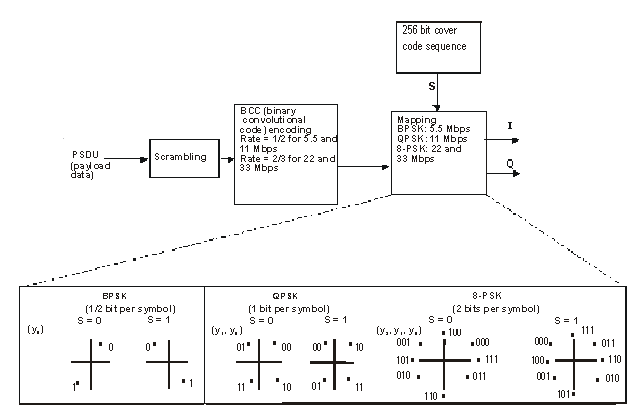
The PBCC payload data is scrambled, then the data is run through a binary convolutional encoder. Two bits are output from the BCC (binary convolutional code) to be mapped using BPSK, QPSK, or 8-PSK, depending on the data rate.
The 16 bit cover code sequence is used to determine the mapping to the constellation points. For the PBCC 5.5 Mbps mode, only ½ bit per BPSK symbol is mapped. The PBCC 11 Mbps data rate uses QPSK, and 1 bit per symbol is mapped for each symbol point. For PBCC 22 and 33 Mbps modes, 2 bits per symbol is mapped. Refer to the following figure.

Figure 1. PBCC coding scheme
The PBCC-33 mode uses a frame structure that is different from the other PBCC modes. In this mode, an additional clock switching structure is added to the frame. The clock switching structures are user-definable. The figure below shows a Signal Studio PBCC-33 frame. Three different sample rates can be chosen for PBCC-33 mode: 33 MHz, 66 MHz, and 99 MHz. The first part of the frame is sampled at 11 MHz, while the second part of the frame is sampled 1.5 times faster, or 16.5 MHz. The example below illustrates the oversample ratio (OSR) applied if a sample rate of 33 MHz is chosen. An OSR of 3 would be applied to the first part of the frame, while an OSR of 2 would be applied to the second part of the frame. The signal generator's arb sample clock would be played back at 33 MHz, thus achieving the 33 Mbps data rate for the PBCC-33 mode.
Per IEEE Std 802.11b-1999 section 18.4.6.6, one byte of zeros is appended to the payload for encoding purposes. The receiver is instructed to discard this byte after decoding. For example, from the Payload Setup menu, Data Length is chosen to be 3 bytes. 1s is chosen as the data type. The resulting payload is comprised of 3 bytes of ones and one byte of appended zeros.
Figure 2. PBCC-33 Clock switching structure
If the 66 MHz sample rate is chosen, an OSR of 6 would be applied to the first part of the frame, and an OSR of 4 would be applied to the second half of the frame. If the 99 MHz sample rate is chosen, an OSR of 9 would be applied to the first part of the frame, and an OSR of 6 would be applied to the second half of the frame.